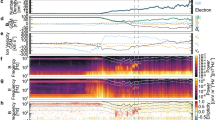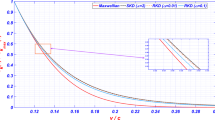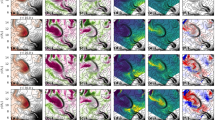Abstract
‘Lion roars’ are intense electromagnetic whistler-mode waves which occur throughout the magnetosheath1. The emissions have a mean frequency near a few tenths of the electron gyrofrequency, a typical amplitude of 0.1 nT and occur in bursts with an average duration of a few seconds2. When played through a loudspeaker the emissions sound like a lion roaring, hence the name. We report here that analysis of simultaneous wave and plasma data obtained on the ISEE-1 satellite indicates that the waves can originate by cyclotron resonant instability with anisotropic magnetosheath electrons whenever the magnetic energy per particle, B2/8πN, falls to values comparable with the electron thermal energy. The variation in this critical energy for instability seems to be associated with the hydromagnetic mirror instability which in turn is excited by the observed pressure anisotropy in the magnetosheath ion population.
This is a preview of subscription content, access via your institution
Access options
Subscribe to this journal
Receive 51 print issues and online access
$199.00 per year
only $3.90 per issue
Buy this article
- Purchase on SpringerLink
- Instant access to full article PDF
Prices may be subject to local taxes which are calculated during checkout
Similar content being viewed by others
References
Smith, E. J., Holzer, R. E. & Russell, C. T. J. geophys. Res. 74, 3027 (1969).
Smith, E. J. & Tsurutani, B. T. J. geophys. Res. 81, 2260 (1976).
Kennel, C. F. Phys. Fluids 9, 2190 (1966).
Kennel, C. F. & Thorne, R. M. J. geophys. Res. 72, 871 (1967).
Crooker, N. U., Siscoe, G. L. & Geller, R. B. Geophys. Res. Lett. 3, 65 (1976).
Williams, D. J., Fritz, T. A., Wilken, B. & Keppler, E. J. geophys. Res. 84, 6385 (1979).
Gurnett, D. A. Scarf, F. L., Fredricks, R. W. & Smith, E. J. IEEE Trans. Geosci. Electr. 16, 225 (1978).
Bame, S. J. et al. IEEE Trans. Geosci. Electr. 16, 216 (1978).
Tsurutani, B. T. et al. J. geophys. Res. (submitted).
Lee, J. C. & Crawford, F. W. J. geophys. Res. 75, 85 (1970).
Nunn, D. Planet. Space Sci. 22, 349 (1974).
Kennel, C. F. & Petschek, H. E. J. geophys. Res. 71, 1 (1966).
Cornwall, J. M., Coroniti, F. V. & Thorne, R. M. J. geophys. Res. 75, 4699 (1970).
Brice, N. & Lucas, C. J. geophys. Res. 76, 900 (1971).
Brice, N. J. geophys. Res. 75, 4890 (1970).
Crooker, N. U. & Siscoe, G. L. J. geophys. Res. 82, 185 (1977).
Chandrasekhar, S. Hydrodynamic and Hydromagentic Stability, Ch. 13 (Oxford University Press, 1961).
Hasagawa, A. Plasma Instabilities and Nonlinear Effects, Ch. 2 (Springer, Berlin, 1975).
Kaufmann, R. L., Horny, J. T. & Wolfe, A. J. geophys. Res. 75, 4666 (1970).
Author information
Authors and Affiliations
Rights and permissions
About this article
Cite this article
Thorne, R., Tsurutani, B. The generation mechanism for magnetosheath lion roars. Nature 293, 384–386 (1981). https://doi.org/10.1038/293384a0
Received:
Accepted:
Issue date:
DOI: https://doi.org/10.1038/293384a0
This article is cited by
-
Direct observations of energy transfer from resonant electrons to whistler-mode waves in magnetosheath of Earth
Nature Communications (2022)
-
Nonlinear whistler wave model for lion roars in the Earth’s magnetosheath
Astrophysics and Space Science (2017)
-
Electron dynamics and wave activities associated with mirror mode structures in the near-Earth magnetotail
Science China Technological Sciences (2014)



